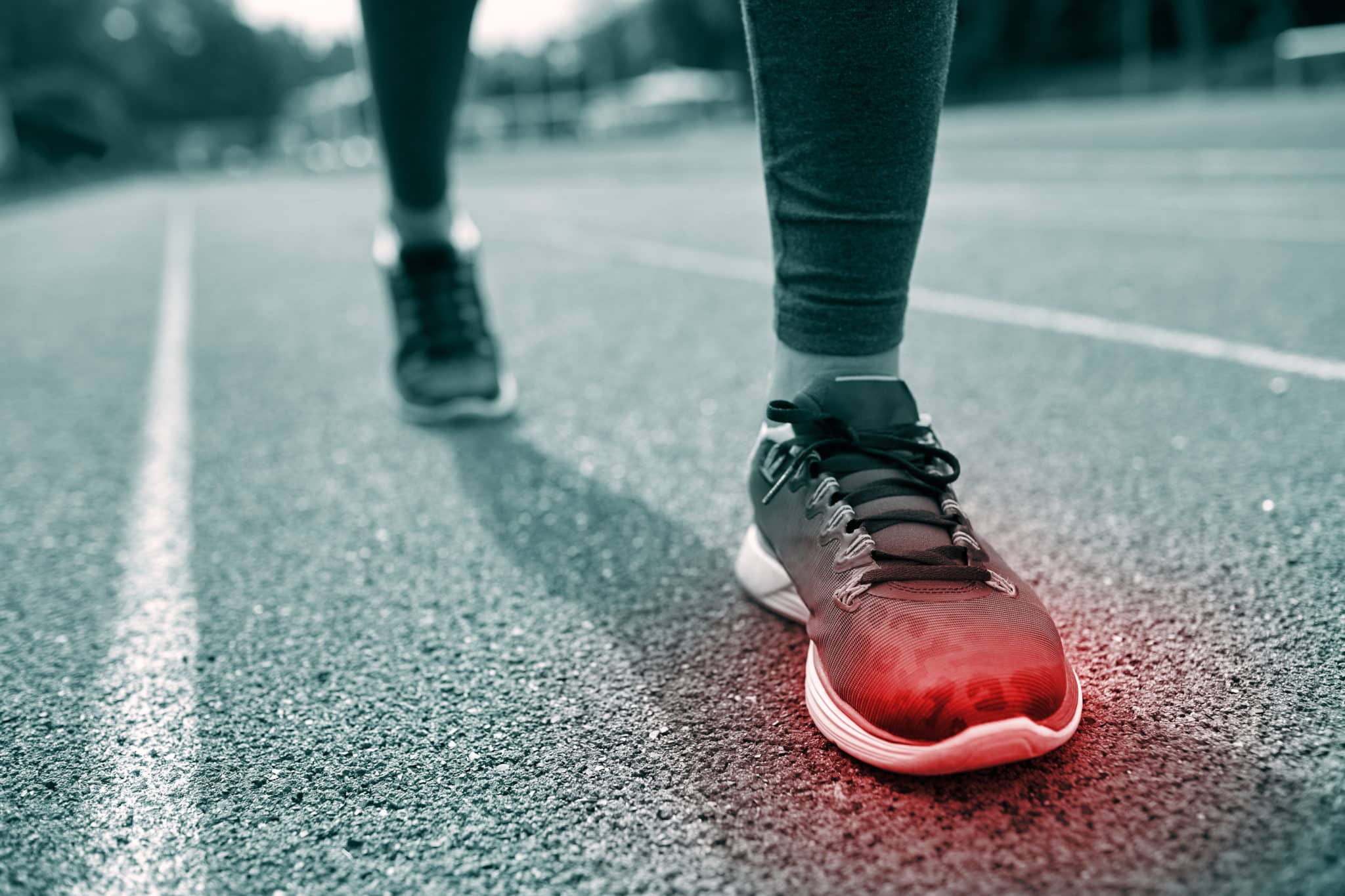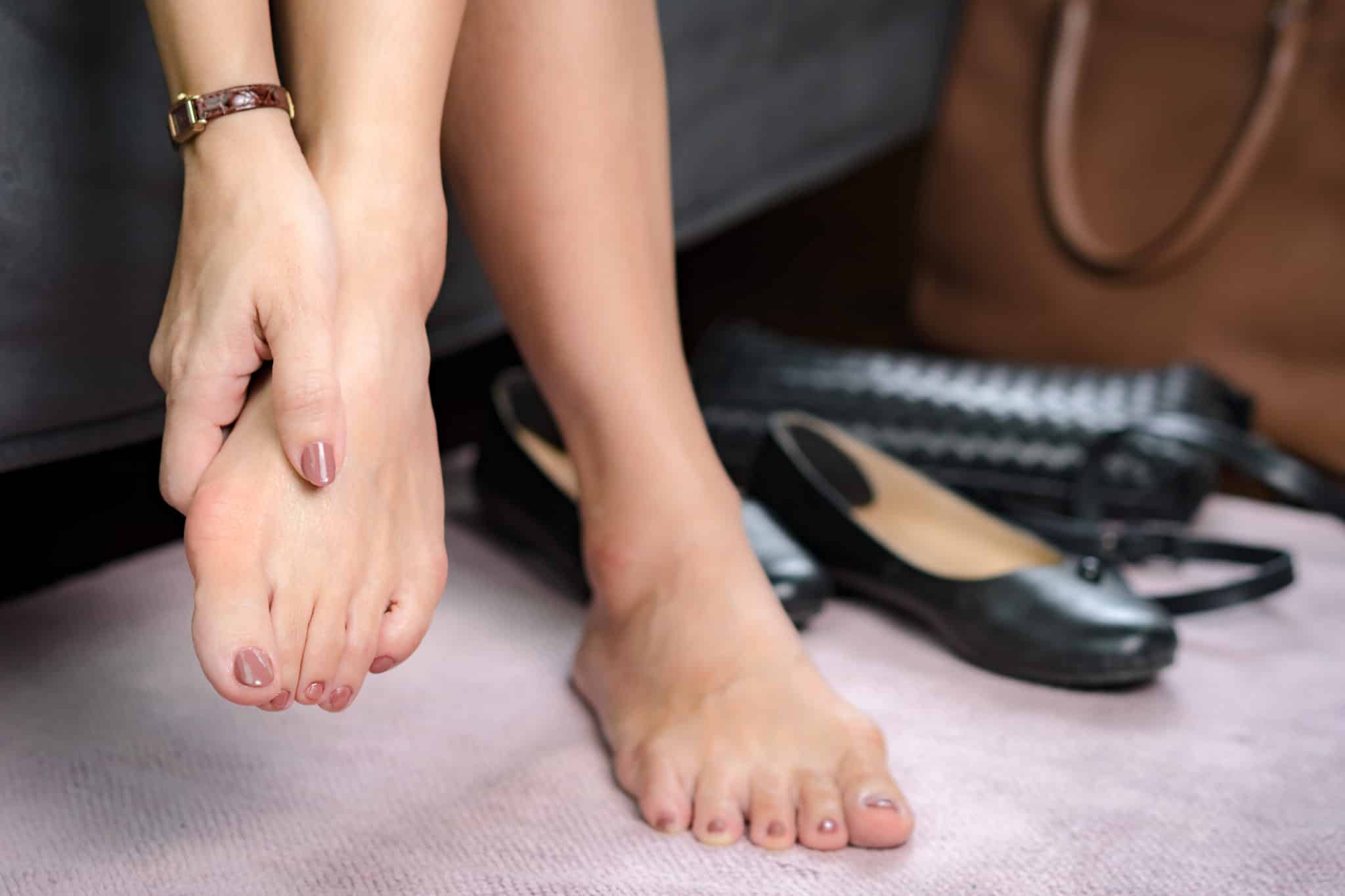It’s one of the most overlooked body parts until it starts to hurt: the foot. Most of us underestimate just how much our feet endure—from standing all day to running marathons; we put our feet through a lot. American Podiatric Medical Association says 70% of Americans suffer from painful feet at some point in their lives. Even though it’s common to have foot pain, it’s never normal. Never ignore painful feet! Foot and ankle pain are not normal, even after a big game or a long run. Ignoring feet that hurt can lead to more injuries.
So if you’re someone who is wondering, “why do my feet hurt?” you’re in the right place. You may have landed wrong after a jump, been wearing improper shoes, or put on too many miles on your run– either way, let’s figure out why your feet hurt and give you tips on how to help them feel better soon!
Let’s look at the most common foot injury types and how to treat them so you can get back on your feet—and back to your workouts.
Foot Injury Types And How To Treat Them

Your treatment will depend on the cause, but it’s best to see a doctor if your foot pain is severe and persists after several days.
Let’s look at some of the most common types of foot injuries—and their treatments—so you can get back to your workouts pain-free ASAP!
1. Plantar Fasciitis
If you have worse heel pain in the morning and gradually improves throughout the day, you might have plantar fasciitis.
What Causes Plantar Fasciitis?
A lack of stretching can lead to chronically tight calves and hamstrings, making you prone to plantar fasciitis. Any exercise that puts a lot of pressure on the heel can also be the culprit, like dancing or running.
What Does Plantar Fasciitis Feel Like?
It can feel like a stabbing or dull pain in the heel or arch of the foot and is often characterized by its gradual lessening of pain throughout the day. This is no reason to ignore it; however—your plantar fascia is the thick connective tissue that runs from your heel to the base of your toes, and damaging it means pain when walking, jogging, or even standing.
How To Treat Plantar Fasciitis
Treating plantar fasciitis can take time, but the sooner you get started, the better. Stretch your lower legs daily and ice your heel for ten minutes a day. Try to stay off your feet and avoid the activity you suspect is to blame for a while until your heel starts to heal!
Related: How to Deal, Heal, and Workout With Plantar Fasciitis
2. Stress Fracture
A stress fracture might not sound as serious as a broken bone, but it can be just as painful. Stress fractures are technically tiny “cracks” in the bone and are common in the legs and feet. The affected area usually feels painful and tender.
What Causes Stress Fractures?
Stress fractures are common among runners who increase their mileage too soon or find themselves “striking” or “landing” improperly; they can also occur in athletes who play on hard surfaces or make a sudden switch to a high-intensity workout plan.
What Does A Stress Fracture Feel Like?
A stress fracture can often start as a dull pain leading many to keep on their normal activity. However, if not treated and rested, the pain will become sharp and noticeable, typically localized to one place.
How To Treat A Stress Fracture
For the most part, stress fractures heal on their own with rest. In some cases, wearing a medical boot may be necessary to avoid putting weight on the affected foot.
3. Ankle Sprains
Connected to your feet, your ankle joints are easy to “twist” if you land funny or misjudge a step. But it’s when your ankle becomes swollen and painful afterward that a true sprain is to be suspected.
Ankle sprains occur when the foot rolls outward, and the ankle rolls inward, hurting the ligaments inside the ankle.
What Causes Ankle Sprains?
Soccer players can easily sprain their ankles, as can other athletes that use intricate footwork and have to change direction commonly suddenly.
What Does An Ankle Sprain Feel Like?
When an ankle sprain occurs, it will likely feel sharp and intense at the moment. The ankle will generally feel stiff and swollen afterward and continue to cause pain with pressure.
How To Treat Ankle Sprains
Use the RICE method: Rest, Ice, Compression, and Elevation.
- Rest the ankle from activity until pain subsides.
- Ice the ankle for 20 minutes every few hours until the swelling subsides
- Compression wraps, like an ACE bandage, will reduce swelling. Wear one for the first few days.
- Elevate your ankle above your heart for a few hours per day to prevent swelling and bruising.
4. Bunions
Ah, bunions. Just the word itself seems to match the condition’s unpleasant nature. A bunion is a large bump on the joint at the base of your big toe.
What Causes Bunions?
Bunions can be caused by wearing shoes that are too tight, a genetic predisposition, or arthritis.
What Do Bunions Feel Like?
Bunions typically form gradually and aren’t marked with pain from a specific moment. In fact, some may not be painful at all but rather bothersome. The skin over the bunion will sometimes be sore, red, and/or warm to the touch.
How To Treat Bunions:
Finding shoes that are comfortable and do not chafe up against the bunion is critical. If the bunion feels inflamed, apply ice to it. You can also find shoe inserts that help distribute pressure more evenly, reducing your foot pain. Unless your bunion causes severe pain, surgery is usually not recommended.
5. Achilles Tendinitis
Your Achilles tendon is a band of tissue that connects calf muscles to your heel bone. Achilles tendinitis occurs when this tendon becomes inflamed.
What Causes Achilles Tendinitis?
Tight calves are often the culprit of Achilles tendinitis. Runners running long distances and increasing their mileage quickly can get Achilles tendonitis, as can tennis or basketball players.
What Does Achillies Tendinitis Feel Like?
Achilles tendinitis is often marked by a mild ache near the back of your lower leg just above your heel. Swelling can also occur along with stiffness in your calf and a reduced range of motion.
How to Treat Achilles Tendinitis
Usually, you can treat Achilles tendinitis at home with ice and rest. Serious cases can lead to tendon ruptures that may require surgery.
6. Turf Toe
Turf toe occurs when your big toe bends beyond its normal range of motion. It is considered a type of sprain and will usually cause swelling.
What Causes Turf Toe?
They call it “Turf Toe” because it often occurs during sports that are played on artificial turf, when your shoe grips to the surface but your body continues to move forward, bending the toe.
What Does Turf Toe Feel Like?
Turf toe can cause a spike of pain if you suddenly hyperextend your toe. The pain is usually worse when you try to manipulate or bend the toe upwards.
How To Treat Turf Toe
Once swelling stops, you can tape your toe to restrict its movement. It’s important to keep the big toe from bending like that again, so you want to keep it steady.
7. Heel Spurs
Heel spurs are a type of bone spur that occurs in the heel. They are essentially “extra bone” that forms on top of normal bone.
What Causes Heel Spurs?
Bone spurs on the feet are often caused by tight ligaments from running, dancing, or jumping. They are also more common in people with flat feet.
What Do Heel Spurs Feel Like?
Heel spurs can cause pain if they press up against other bones or tissue. Many people describe this as a sharp prick or knife stab in the bottom of their foot upon standing in the morning. It can then become dull again until another bout of sitting/lying down and then applying pressure.
How To Treat Heel Spurs
Make sure to incorporate more calf stretches into your exercise routine to relieve those tight ligaments and avoid the offending activity that you think has caused your heel spur until the pain subsides.
Tips For General Foot Pain Relief
Keep your feet healthy with these tips to prevent foot injuries and relieve current foot pain at the same time. If you aren’t sure why you have painful feet, try one of these easy and therapeutic tips to help relieve foot pain.
1. Stretch Your Feet
Your feet need just as much love as your legs or arms do—don’t forget about them when you’re warming up and cooling down.
Stretch your ankles, open them up using foot savers (they help open up your toes if they’re prone to getting “scrunched” together) and use moves like downward dog that stretch all through your legs AND your feet, to give you a really nice release.
2. Don’t Overdo It Before You’re Ready
When you start an exercise regimen, it can be tempting to go “all in” and think you need to go as fast or hard as possible. But truly, the best way to avoid exercise injuries of ANY kind is to ease into your fitness regimen and gradually increase what you’re doing.
Just as you wouldn’t try to lift a barbell three times heavier than one you did last week, don’t increase your running mileage by too much too soon!! It’s an easy way to injure your feet and leave you out of commission.
3. Ice Recent Injuries; Use Heat On Chronic Pain
Typically, ice works best on new injuries (6 weeks or sooner), and heat works better on chronic pain caused by conditions like arthritis. Since it can be hard to keep an ice pack on your feet, some people use a frozen water bottle and roll it beneath their feet for relief for about 15-20 minutes per day.
4. Wear The Right Shoes
The right footwear can mean the difference between treating your feet right and putting them through the wringer.
Be sure you’re wearing the proper footwear for your workout; running shoes and cross-trainers are different for a reason: to protect the way your foot moves during the activity.
Podiatrist Dominic Catanese says that minor foot problems that don’t make much difference at other times “suddenly become a huge deal when you begin putting significant stress on your feet, as you do when starting an exercise program.”
If you’re experiencing foot injuries, be sure to follow our treatments above!


4 Comments
Susan Coon on May 26, 2020 at 11:11 AM
This was very helpful/informative. Thanks for sharing. I love participating in your classes at Dallas Mania. Not sure what it will be like for Aug. 2020.
Brian Andrew on August 25, 2018 at 4:36 AM
Hello I got injured on my lower foot three months ago I got a fracture and it healed but there is still some pain can I try some cone exercises
Chris Freytag on August 27, 2018 at 1:20 PM
Hi Brian - without knowing much about your injury and healing process, it's hard for me to answer that. It's best to talk to your doctor or physical therapist if you're wondering what exercises are safe for you moving forward. Thanks!
Plee on February 1, 2017 at 9:22 PM
I enjoy all your e-mails. They help to keep me motivated.The recipes keep my meals interesting,and your advice on how not to get injured help me in my daily workout or just in my daily activities. I would like to thank you for your help and motivation in my daily workout. My goals are to workout in hope to reach my desire life change.